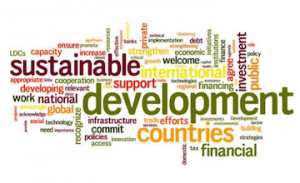Financing the Future – SDGs should leave no one behind
 This week sees the final negotiations on the Sustainable Development Goals. Unless there are last minute upsets – less and less likely following a mostly successful financing conference, but always possible – two years of hard work essentially come to an end in the next fortnight.
This week sees the final negotiations on the Sustainable Development Goals. Unless there are last minute upsets – less and less likely following a mostly successful financing conference, but always possible – two years of hard work essentially come to an end in the next fortnight.
The process has been an extraordinary one: millions, literally, of people around the world have been asked what they want from it. From now on, it will be difficult for multilateral negotiations and decision-making fora not to include the views and voices of ordinary citizens.
The final outcome document is very unlikely to be perfect: anyone who expects it to be otherwise perhaps needs to swallow a dose of reality. But it will set out a normative framing that has the potential to lift the lives of billions of people. And this is the point: that this time round, the SDGs, unlike the MDGs, need to have the poorest, most vulnerable, and most disadvantaged, at their heart.
This is one of the few parts of the development agenda that is truly universal. Of course, being female, unemployed and disabled looks and means something very different in London than it does in Bujumbura. But every country has pockets – and often very, very large ones – of deprivation.
And that’s is also part of the reason for optimism around the issue. Just as every country exhibits the symptoms, so does every country have within its wherewithal the cure. The proof of this is that a range of countries have already been implementing policies that specifically target chronic poverty in all its various forms.
Some of these countries are relatively better off. Brazil runs Brasil Sem Miséria, or Brazil Without Extreme Poverty. Spun off from the Bolsa Família, this pursues economic inclusion by creating employment opportunities for the poor and building collaboration between the public and private sectors. One part of it, for example, the Brazilian Food Purchase Progamme buys the ingredients for school meals from local farmers, and poor workers are employed to cook them in community kitchens. Another gives conditional cash transfers. Professional teams go door to door actively seeking out the poor and logging them in a single national register with their municipal institutions, meaning they can more readily access public services.
But even the poorest countries are able to run targeted policies. In Eritrea (where GDP per capita is just $590) there’s a joint government and UNICEF programme to ensure the children of nomadic herders attend primary school – they tend to be excluded from the formal education system as their seasonal migration is out of step with the school calendar. There are now 100 Complementary Elementary Education Centres in the country, and around 30,000 children have benefitted from it, just under half of whom are girls.
Although there is now not going to be a fully revised version of the draft SDG text, there is still room to strengthen the language on leaving no one behind so that all governments implement analogous programmes. Specifically, there should be language committing all countries to identifying their excluded groups.
This will, of course, entail developing the data to do so, and observing that people are marginalized is clearly only a first step: but it’s a vital one if the SDGs are to do the MDG’s unfinished business.
By: Elizabeth Stuart,
Research Fellow and Team Leader, Sustainable Development Goals, ODI
Source: post2015.org
